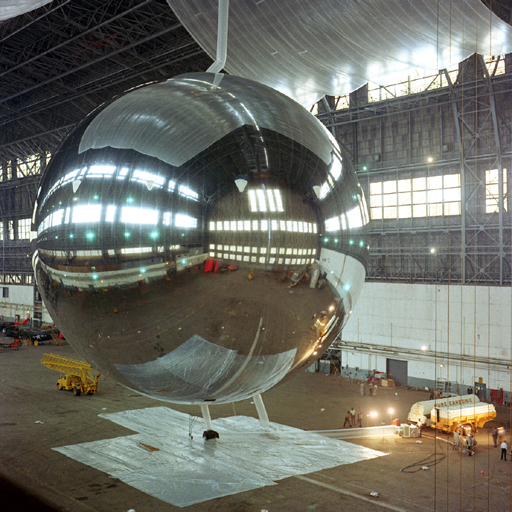|
The Space Ball ProjectSatellite Description |
The Space Ball project is focused around a very large reflective satellite reminiscent of the 40m diameter ECHO satellite launched by the USA in 1960:

Test inflation of an Echo satellite in a blimp hangar at Weeksville, North Carolina. NASA photo. ( http://grin.hq.nasa.gov/ABSTRACTS/GPN-2000-001896.html)
As a preliminary design, the Space Ball is a large sphere, 100m (330ft) or more in diameter, made of a reflective material such as aluminized Mylar. It is inflated in orbit, filled with an open-pore hardening foam so that its shape is maintained when a leak develops. Its weight would probably be around 100 kg. (220 lbs.). The orbit is high enough to keep it clear of the drag of most of the atmosphere, but low enough that on a clear night it will be clearly visible to the unaided eye as a bright dot moving across the sky. The orbital period will probably be of the order of 90 minutes. The Space Ball will have an orbit that will make it visible from most of the earth's populated surface on a frequent basis. It may even be visible occasionally in the daytime if the conditions are optimal.
|
|
Space Ball
Space Ball will have interesting visual characteristics. One hemisphere will be tinted red, the other blue. Space Ball will spin around an axis that is perpendicular to the direction to the sun, consequently, the bright dot seen from the earth will change between red and blue. Red and blue span the human visible spectrum. Space Ball will also have at one pole a large mylar retroflector of 3m (10 ft) size. A retroflector reflects light back from the same direction the light comes from; reflective automobile sidelights are examples of retroflectors. When Space Ball is low on the horizon and the sun is low on the opposite horizon, Space Ball will create flashes of light as it turns. These visible events will be infrequent for any given location, but will happen frequently someplace. They are predictable, locally rare, occurrences. Both the skin and the retroflector will reflect shortwave radio waves.
This description is only a suggestion. The design, the colors, the orbit and even the name of the satellite will actually be developed by the learners around the globe. They "own" it.
I would like to hear your ideas on how this project can move forward.
http://www.tomwason.com
+1 919.839.8187
+1 919.602.6370 (cell)
1421 Park Drive
Raleigh, NC 27605 USA
Copyright © 2001 - 2006 Thomas D. Wason
